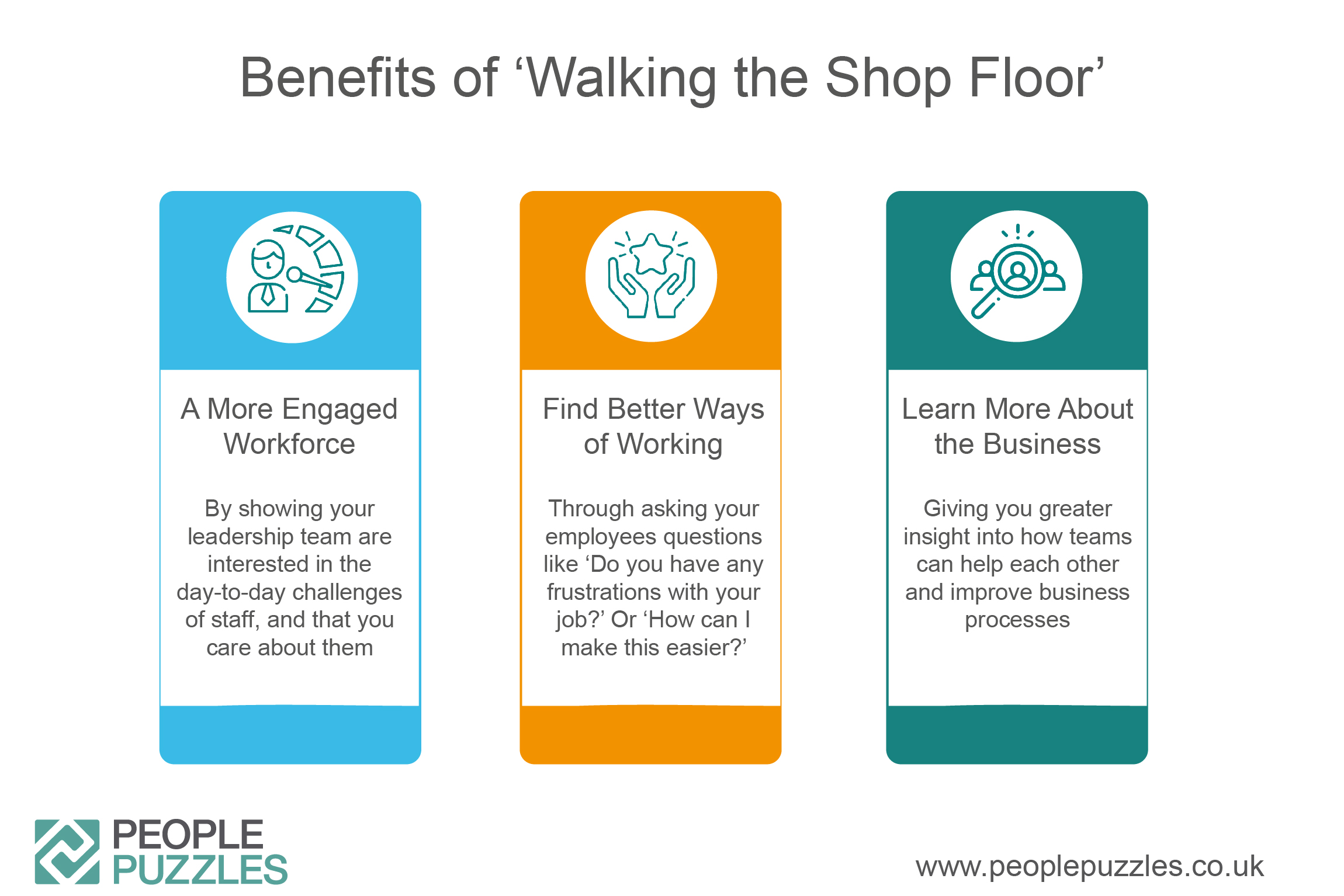Five benefits of walking the ‘shop floor’
‘Walking the shop floor’ is a term where the business owner or manager – or the leadership team in larger organisations – spends time in the business talking to those working at the coal face. In a factory, this would be the production line; in an IT firm it would be the developers; in a courier company it would be the drivers.
Many managers and MDs find that doing a regular shop floor walk has multiple benefits.
Read on and see how this management style could benefit your business:

Benefit 1: Having a more engaged workforce
It’s well documented that an engaged workforce will perform well, meaning better results in the company. If you’re a Managing Director it’s possible you have become removed from the people on the shop floor and tend to spend most of your time in your office or meeting clients.
By walking around the ‘shop floor’ you can start to build a culture where the leadership is interested in the day-to-day challenges of staff and making them feel comfortable in their roles. It’s showing that you’re around and that you care about them and what they do.
Benefit 2: Finding better ways of working
A very practical benefit of walking the shop floor is that it gives you the perfect opportunity to ask your employees questions like:
- Do you have any frustrations with the job?
- How can I make this easier?
- How could we do it differently to make it better?
By doing this, you’re not acting like a leader who just tells employees what to do, you’re asking the person doing the job how they would improve it; empowering them to make it work better.
Benefit 3: Learning more about the business
Senior leaders should be interested in all sides of the business, not just their own department. Going into different parts of the business gives a greater insight into how teams can help each other.
I’ve worked in companies where the whole executive team would spend the day working in a different team within the business. The sales director, for example, would spend the day with production and distribution, getting a deeper understanding of the challenges in these parts of the business that could impact customers and sales.
Benefit 4: Building the culture of the business
The term ‘visible felt leadership’ is often used in industries where the work involves significant safety risks. It’s where leadership teams walk the shop floor and ask workers about the risks involved in the job and whether they feel safe. By showing that the people at the top are prepared to give their time to talk to the people who are most likely to get hurt in their jobs about their safety, a safety culture is built.
This idea isn’t just restricted to safety, it can almost certainly be done in places where other aspects of the business are paramount, such as quality or customer service.
Benefit 5: Reaching out to remote sites
In multi-sited businesses, there is a danger that those working in remote sites feel isolated or ignored. A company I work with combats this by holding senior management meetings at a different site each month. While they are there, the team walks around the site talking to people. This helps those teams feel part of the business and that their work counts as much as that carried out in head office.
Why not just have a meeting?
You’re far more likely to have more relaxed and insightful conversation with staff on the shop floor where they’re doing what they know, than in the formal setting of a meeting room or your office. Plus you’re more visible to other employees, not just the ones you talk to.
Tips for a successful shop walk
There’s a skill in how you engage so it doesn’t come across as a box-ticking exercise. It helps if you bear the following in mind:
- Build a rapport by asking how they are and show interest in what they are doing. If they have photos of their family, pets or favourite football team, ask about them.
- Demonstrate you’ve listened by following up on your conversation. This could be as simple as sending an email saying thanks for the day, or if they’ve suggested something to improve their job, set wheels in motion to improve it.
How much time should you spend walking the shop floor?
Many managers are pushed for time; they have clients to meet, paperwork to sign off and tricky problems to solve. But four hours a month is not an unreasonable amount of time to spend in your business; perhaps a day a month in a multi-site organisation.
In fact, the benefits in taking regular time out from your management role to proactively engage with your staff may even prevent some of those tricky problems arising in the first place.
Written by Jim Verity, People Director.
If you would like any advice on the best way to add this into your diary or for other tips on how to better engage with your team please contact us or drop us an email on [email protected].


